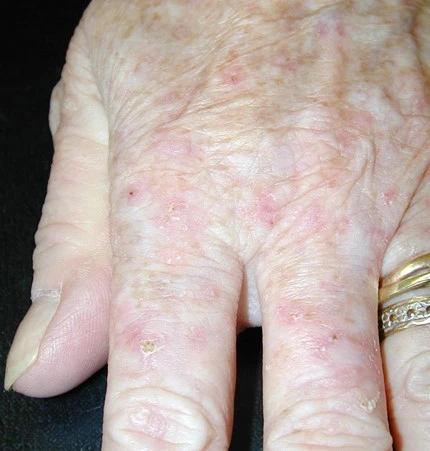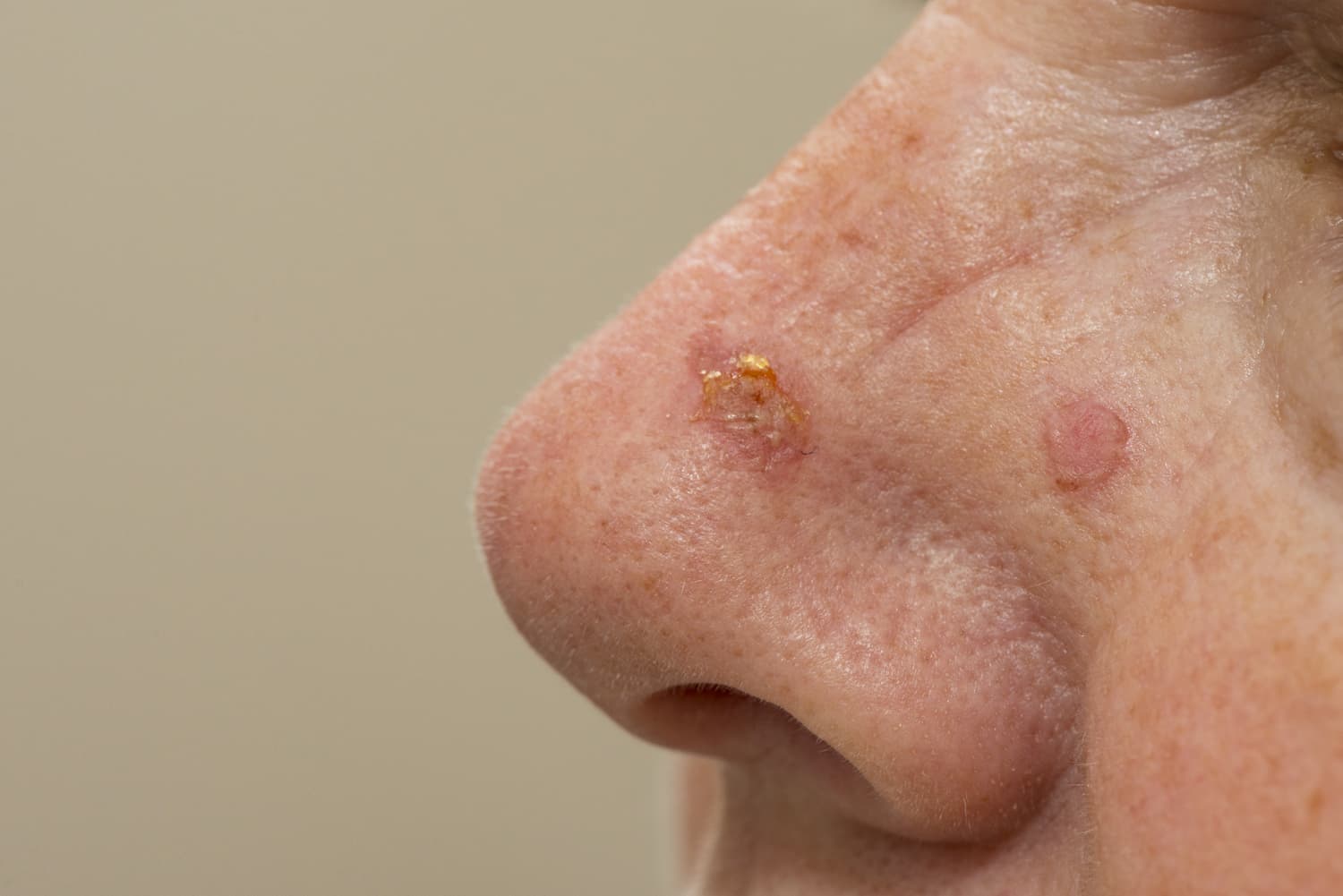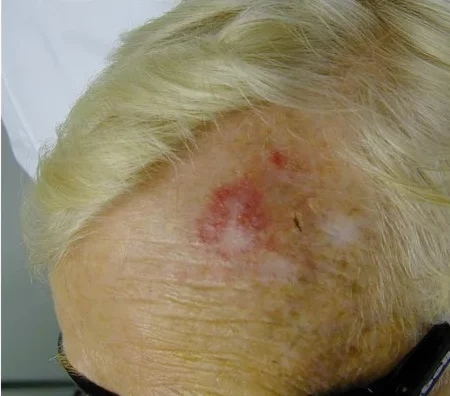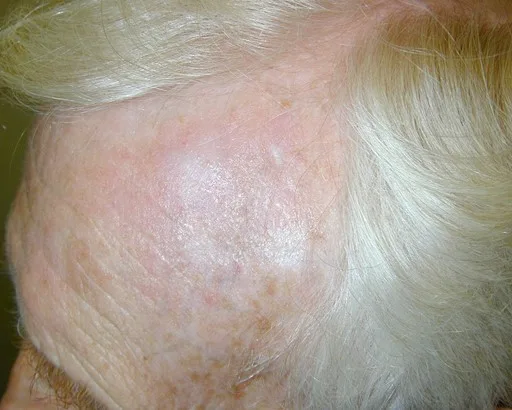What is solar keratosis?
Solar keratosis (also known as Actinic keratosis) are patches of dry, scaly skin, which may cause itching and irritation. They commonly occur on the scalp, face, ears, forearms, and back of the hands. They are very commonly seen on the scalp in men who have hair thinning.

Are solar keratosis harmful?
Generally speaking, solar keratosis are not harmful and can be left untreated if they are not causing any symptoms. Up to 25% of early solar keratosis will resolve spontaneously without treatment.
The risk of a Solar keratosis changing into a skin cancer is very small (less than 1 in 1000 lesions). In the majority of patients, there is often surrounding sun-damage change to other areas of the skin so there is always a small risk of skin cancer developing over time. Typical warning signs of cancerous change are pain and soreness developing in a lesion or rapid growth of the skin lesion. Thickened lesions may need more active treatment because they do not respond as well to topical treatments and tend not to disappear without treatment.

Treatments for solar keratosis
Very early solar keratosis do not need treatment and may resolve spontaneously. However, treatment may be warranted if they itch, bleed, or if there is any concern about the development of a skin cancer. The daily application of a moisturiser such as E45® or Vaseline Intensive Care® may help alleviate symptoms. Sun avoidance is necessary to help reduce the number of new lesions developing.
Persistent solar keratosis may require treatment.
There are several effective treatment options:
Solaraze gel®
(diclofenac and hyaluronidase):
This is applied twice daily for 6-12 weeks to be effective. For early lesions, it can be applied for a shorter duration of 3-4 weeks. It works by causing inflammation in the unstable skin cells. Treated skin lesions look worse before they improve. They may become red, angry-looking, and weep with treatment but this is not usually too uncomfortable. Solaraze® is about 70% effective and works best in early superficial lesions. Treatment courses may be repeated.
Efudix cream® (5-fluorauracil cream):
Efudix® is applied twice daily for 3-4 weeks or once daily for 4-6 weeks to a small area of affected skin. It must be applied to a very small area and no larger than the size of the palm of your hand for the first course (less than 8-10cm2). This is because it can cause intense inflammation in both the lesion and any surrounding skin that has early sun-damage. With time, some patients find they can treat larger areas but most find it is better to apply to a small area and then move to other areas over a number of weeks.
If you apply it to the whole face or scalp, it can cause significant inflammation and whilst this is not serious, it can look very unsightly.
It works by destroying abnormal skin cells and causes a pronounced inflammation in skin lesions. It is normal to see redness, crusting, and rarely ulceration. Treatment may need to be stopped for a few days if the reaction is very intense. You may need to ask your GP to prescribe a topical steroid/antibiotic (Fucibet® cream) if the reaction is severe and unexpected. It is 85% effective and is very effective for multiple unstable lesions. Treatment courses can be repeated or rotated around different areas. Some experienced users find it can be used for 2-3 weeks on individual lesions that crop up with good results.
Cryotherapy freezing (liquid nitrogen):
Cryotherapy destroys the unstable skin cells allowing healthy skin cells to heal the treated area. Freezing typically takes a few seconds and wounds heal in 7-15 days. It is relatively painful but very effective (90% of skin lesions will resolve with a single freeze). Side-effects include blistering, crusting and occasionally a white permanent scar.
Skin curettage & cautery:
This technique tends to be used for thickened lesions that may not respond to topical treatments or cryotherapy. The procedure involves an injection of local anaesthetic into the skin followed by gentle scraping with a device called a curette. This removes the abnormal cells of the skin. It is followed by cautery to seal the bleeding blood vessels. Treated areas usually heal well within 10-21 days.
Curettage may cause a permanent white or pale scar and there is always a small risk of recurrence. Facial lesions usually completely heal in 7-14 days. Healing on the lower leg can be slow and take many weeks to completely recover. Occasionally, a raised scar may develop in treated areas especially on the chest that may necessitate an injection of steroid.
Photodynamic therapy:
Extensive facial or scalp solar keratosis may require treatment with Photodynamic Therapy. A cream containing a photoactive substance is applied to individual lesions or field change. It is selectively absorbed by abnormal skin cells to make a photosensitive chemical that allows selective destruction of unstable sun-damage and specific types of early pre-cancerous change. The technique is mainly used for larger areas of sun-damage when other treatments have failed.
It is particularly useful in treating patients with more than 8-10 skin lesions. It is about 75% effective and treatment effects last for several years. Complications include some discomfort during treatment and redness lasting a few weeks. It can be used for extensive disease and has the advantage that healing only takes 7-10 days with good cosmesis. Multiple treatments may be required and each session is typically 70-75% effective.
Do I need to be seen regularly by a dermatologist?
No, your GP can normally review your skin and prescribe topical treatments. In specialist services, we normally see patients for assessment for higher risk lesions, patients with severe persistent lesions, or for investigation of lesions that change. We do not routinely review patients with Solar Keratosis unless there is a suspicion of cancer or patients with unstable skin.
Can I do anything to help the skin problem?
Studies have shown that avoidance of further exposure to sunlight reduces the number of new skin lesions by 25%. It is advisable to avoid sun exposure by covering up with light clothing, use of a wide-brimmed hat, and by wearing a high Sun Protection Factor (SPF>50) sunscreen containing both UVA and UVB protection. Try and avoid sun exposure between 11am and 3pm. The application of regular moisturisers may also help such as E45 cream or any other plain cream.






